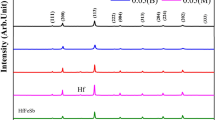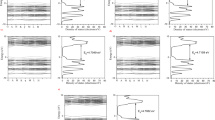Abstract—
New Gd- and B-containing compounds, Y3 –xGdxAl2(AlO4)3 – 0.01x(BO4)0.01x with the garnet structure and Y1 –xGdx(AlO3)1 – 0.01x(BO3)0.01x with the perovskite structure, have been synthesized in the range x = 0.2–1.0 via coprecipitation method and characterized by X-ray diffraction and IR spectroscopy. The formation of a continuous series of solid solutions with the expected garnet structure has been demonstrated. We failed to obtain compounds with the perovskite structure. Assessment of the cytotoxicity of the synthesized compounds with the garnet structure has shown that they have no significant effect on blood cell viability in experimental animals.






Similar content being viewed by others
REFERENCES
Hawthorne, M.F. and Lee, M., A critical assessment of boron target compounds for boron neutron capture therapy, J. Neurooncol., 2003, vol. 62, nos. 1–2, pp. 33–37. https://doi.org/10.1023/A:1023253309343
Hosmane, N.S., Maguire, J.A., Zhu, Y., and Takagaki, M., Principles of neutron capture therapy, in Boron and Gadolinium Neutron Capture Therapy for Cancer Treatment, Singapore: World Scientific, 2012, p. 35. https://doi.org/10.1142/9789814338684_0003
Barth, R.F., Coderre, J.A., Vicente, M.G.H., and Blue, T.E., Boron neutron capture therapy of cancer: current status and future prospects, Clin. Cancer Res., 2005, vol. 11, no. 11, pp. 3987–3992. https://doi.org/10.1158/1078-0432.CCR-05-0035
Kageji, T., Nagahiro, S., Mizobuchi, Y., et al., Boron neutron capture therapy (BNCT) for newly diagnosed glioblastoma: comparison of clinical results obtained with BNCT and conventional treatment, J. Med. Invest., 2014, vol. 61, nos. 3–4, pp. 254–262. https://doi.org/10.2152/jmi.61.254
Van Rij, C.M., Wilhelm, A.J., Sauerwein, W.A., and van Loenen, A.C., Boron neutron capture therapy for glioblastoma multiforme, Pharm. World Sci., 2005, vol. 27, no. 2, pp. 92–96. https://doi.org/10.2217/fon.12.118
Liu, Y.W., Chang, C.T., Yeh, L.Y., et al., BNCT treatment planning for superficial and deep-seated tumors: experience from clinical trial of recurrent head and neck cancer at THOR, Appl. Radiat. Isot., 2015, vol. 106, pp. 121–126. https://doi.org/10.1016/j.apradiso.2015.08.002
Aihara, T., Morita, N., Kamitani, N., et al., BNCT for advanced or recurrent head and neck cancer, Appl. Radiat. Isot., 2014, vol. 88, pp. 12–17. https://doi.org/10.1016/j.apradiso.2014.04.007
Menéndez, P.R., Roth, B.M., Pereira, M.D., et al., BNCT for skin melanoma in extremities: updated Argentine clinical results, Appl. Radiat. Isot., 2009, vol. 67, pp. S50–S55. https://doi.org/10.1016/j.apradiso.2009.03.020
Zonta, A., Prati, U., Roveda, L., et al., Clinical lessons from the first applications of BNCT on unresectable liver metastases, J. Phys: Conf. Ser., 2006, vol. 41, pp. 484–489. https://doi.org/10.1088/1742-6596/41/1/054
Barth, R.F., Vicente, M.G., Harling, O.K., et al., Current status of boron neutron capture therapy of high grade gliomas and recurrent head and neck cancer, Radiat. Oncol., 2012, vol. 7, pp. 146–151. https://doi.org/10.1186/1748-717X-7-146
Luderer, M.J., de la Puente, P., and Azab, A.K., Advancements in tumor targeting strategies for boron neutron capture therapy, Pharm. Res., 2015, vol. 32, no. 9, pp. 2824–2830. https://doi.org/10.1007/s11095-015-1718-y
Salt, C., Lennox, A.J., Takagaki, M., et al., Boron and gadolinium neutron capture therapy, Russ. Chem. Bull.,Int. Ed., 2004, vol. 53, pp. 1871–1878. https://doi.org/10.1007/s11172-005-0045-6
Brugger, R.M. and Shih, J.A., Evaluation of gadolinium-157 as a neutron capture therapy agent, Strahlenther. Onkol., 1989, vol. 165, nos. 2–3, pp. 153–158.
De Stasio, G., Casalbore, P., Pallini, R., et al., Gadolinium in human glioblastoma cells for gadolinium neutron capture therapy, Cancer Res., 2001, vol. 61, no. 10, pp. 4272–4277.
Shih, J.L.A. and Brugger, R.M., Gadolinium as a neutron capture therapy agent, Med. Phys., 1992, vol. 19, no. 3, pp 733–738. https://doi.org/10.1118/1.596817
Golovkina, L.S., Orlova, A.I., Nokhrin, A.V., et al., Ceramics based on yttrium aluminum garnet containing Nd and Sm obtained by spark plasma sintering, Adv. Ceram. Sci. Eng., 2013, vol. 2, no. 4, pp. 161–165.
Potanina, E., Golovkina, L., Orlova, A., et al., Lanthanide (Nd, Gd) compounds with garnet and monazite structures. Powders synthesis by “wet” chemistry to sintering ceramics by spark plasma sintering, J. Nucl. Mater., 2016, vol. 473, pp. 93–99. https://doi.org/10.1016/j.jnucmat.2016.02.014
Laverov, N.P., Velichkin, V.I., Omel’yanenko, B.I., et al., Izmenenie okruzhayushchei sredy i klimata: prirodnye i svyazannye s nimi tekhnogennye katastrofy (Environment and Climate Changes: Natural and Related Industrial Disasters), vol. 5: Izolyatsiya otrabotavshikh yadernykh materialov: geologo-geokhimicheskie osnovy (Isolation of Spent Nuclear Materials: Geological and Geochemical Principles), Moscow: Inst. Geologii Rudnykh Mestorozhdenii, Petrografii, Mineralogii i Geokhimii (IGEM), Ross. Akad. Nauk, 2008.
Pena, M.A. and Fierro, J.L.G., Chemical structures and performance of perovskite oxides, Chem. Rev., 2001, vol. 101, pp. 1981–2018. https://doi.org/10.1021/cr980129f
Davies, R.A., Islam, M.S., Chadwick, A.V., and Rush, G.E., Cation dopant sites in the CaZrO3 proton conductor: a combined EXAFS and computer simulation study, Solid State Ionics, 2000, vol. 130, no. 2, pp. 115–121. https://doi.org/10.1016/S0167-2738(00)00573-7
Davies, R.A., Islam, M.S., and Gale, J.D., Dopant and proton incorporation in perovskite-type zirconates, Solid State Ionics, 1999, vol. 126, no. 4, pp. 323–329. https://doi.org/10.1016/S0167-2738(99)00244-1
Funding
This work was supported by the Russian Foundation for Basic Research, grant no. 18-33-00880.
Author information
Authors and Affiliations
Corresponding author
Rights and permissions
About this article
Cite this article
Alekseeva, L.S., Pushkova, D.A., Gorshkov, A.P. et al. New Mineral-Like Gd- and B-Containing Compounds for Neutron Capture Therapy. Inorg Mater 56, 198–203 (2020). https://doi.org/10.1134/S0020168520020016
Received:
Revised:
Accepted:
Published:
Issue Date:
DOI: https://doi.org/10.1134/S0020168520020016




